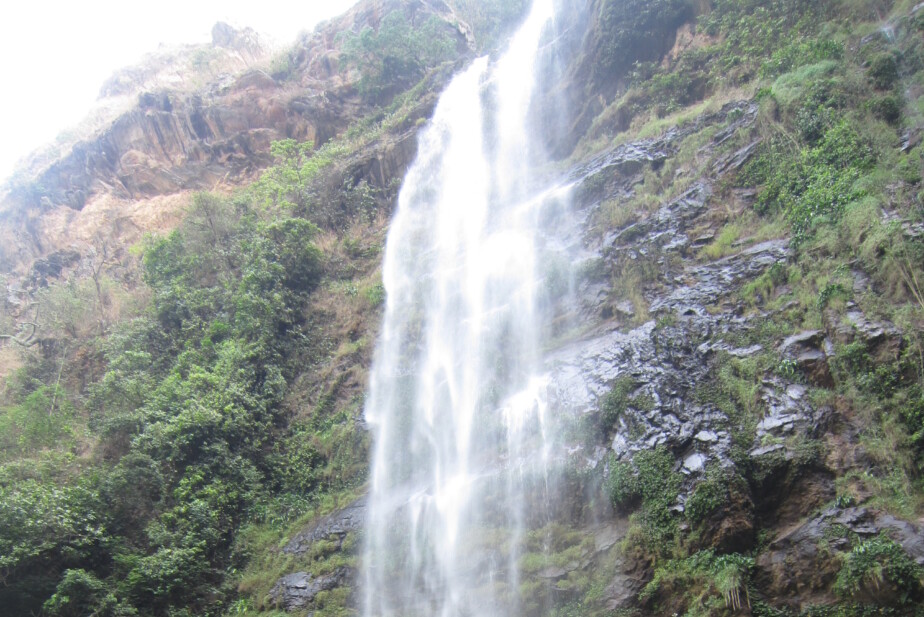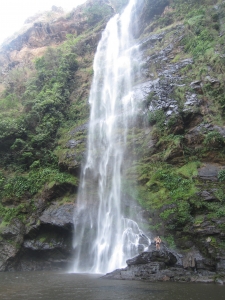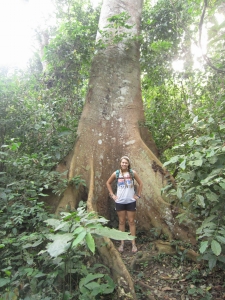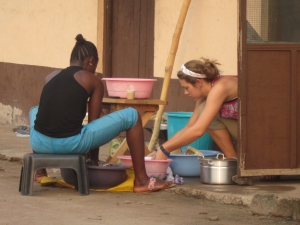
The following post is from Anna Brodmerkel, a 2014 Global Gap Year Fellow. UNC’s Global Gap Year Fellowship is housed in and staffed by the Campus Y. Find out more about the fellowship on our GGYF Facebook page!
On this Sunday afternoon, I am sitting where a slight breeze flows underneath the short tree in the front yard with long, y-shaped branches to create a rare spot of shade in hopes that I can explain the vast and perplexing spectrum of Ghana’s wealth. I should be able to write as most of the children are attending church services with staff, which allows for a quiet and relaxed morning, something I am unaccustomed to here at YAP Ghana.
The only noise comes from the various church services in session on the other side of our compound’s concrete wall. I can hear one pastor preaching in Twi in between hymns accompanied with what sounds like a tambourine, but is more likely an akaye, a gourd-shaped instrument covered with a beaded net. Further away, the congregation of another church sings along to music blasting from a sound system. But this extra noise does not prevent me from writing; it is my preoccupation with two colors: brown and green.
***
In my two trips to the Volta Region, home of the Ewe Tribe and multitudes of mango plantations, I’ve found that the wealth appears to be the same dry and dusty color as the clay roads in contrast to the flourishing plant life teeming with shades of tropical green. Even in what I would classify as “touristy” areas, such as Ho, Hohoe, and Wli, the people do not prosper as one might think. Although Ho and Hohoe are classified as cities and transport hubs, there is not much see or do there unless one needs to purchase any necessities or food items at the countless roadside stores.
The trek through Hohoe to reach Wli to hike to the Wli Waterfalls, highest in all of West Africa and adjacent to Togo, was not an easy task. Consistent with other roads passing through small villages in Ghana, the roads to reach the magnificent falls provided half the adventure, bumping up and down due to giant pot holes and other road deformities. Along these roads, which many would probably consider unsutiable for tires, I encountered villages of mud huts with thatched roofs, only able to serve the most basic of needs. These are the villages one might expect to see in a National Geographic magazine, ones that resemble the preconcieved notions of “Africa” people of developed nations seem to have. These are the villages I assume most people in my community in the states were terrified I would be living in, not in the “suburban” area of Adenta, Accra.
Wli consits of more than huts, but is still just a tiny village consisting of little more than guesthouses, small roadside stores, a dirt soccer field, a library, and a school. Unfortunately, unlike the water that trickles down the lush, green mountain, the wealth does not trickle down to the villagers from the tourists, leaving the villagers’ wallets barren. I was surprised by this fact, as I thought the falls would attract more people, both Ghanaian and non-Ghanaian. Although deprived of the abundant beautiful rain forest landscape characteristic of the Volta Region, Accra beckons Ghanaians from all regions and foreigners with the promise of “fortune.”
***
Accra comprises several areas to create the capital city of Ghana. I live in Adenta, a small area in the northern part of the city. In an hour of what I like to call “tro-tro time” (tro-tros* are the system of public transportation in Ghana), I can make it to the more urban and modernized part of Accra, known as “Accra,” where the airport, Independence Square, Arts Center, and the Flagstaff House which houses the president are located. With another thirty minutes I can get to Osu, where many embassies, tourist sites, and up-scale restuarants are located. And if one is looking for a party spot, Labadi Beach is the place to go, albeit two hours away from Adenta. Commuting from one end of the city to the other can be a pain, and the journey may not always be worth it, but I think it’s important to see the entirety of the city.
Throughout my escapades in the city, I noticed the undeniable differences between social classes. Coming to Ghana I expected to see the impoverished, but not in such close proximity to the wealthy. When walking through an upscale area, it’s common to see many people sleeping on the side of the street, or on the bench by the stand where they sell food or phone credit. I’m completely astonished by the tremendous difference in lifestyle, and although I knew it existed, it’s a disturbing experience to see how close the two coexist, yet the only contact could be pedestrians weaving in and out of moving traffic trying to sell various assortments of food or goods in the roads to people in BMW’s.
The first time I left the Adenta/Madina area (and stayed in Accra) to go to the Accra Mall shocked me more than anything else. The mall could compete with smaller, westen malls with it’s food court, movie theater, and trendy, brand-name, overpriced shops. Not only a watering hole for other “Obrunis**,” there were plenty of Ghanaians who could afford to shop there as well. People can easily spend the brown fifty cedi^ notes, while the hawkers outside of the mall depend on every 50 pesewas^^ people spend to buy the green mangos, unripe plantains, and avacodos. This may sound terrible, but I had yet to experience such a place in Ghana at the time and did not expect to encounter one. I left the mall feeling confused and uneasy, something I would undergo again when searching for a restaurant to meet a friend.
On my way to the restaurant, I asked a woman at a roadside booth for directions because I was a bit turned around. She was sorry to say she didn’t know, but I eventually found my way as I was only a street off. Later that night while sitting in the posh restuarant, it occured to me that she would not know the location, or even the restuarant name, because she could never afford to eat there. This fact astonished me, and I could not grasp the complete contrast of Ghanaian lifestyles where the wealthy have all the green^^^ in their wallet, while the poor may not even be able to afford a wallet.
I began to feel physically sick when I first encountered these situations over a month ago. My eyes could not digest what they saw, and I felt my first real bout of culture shock. How this could happen? Why can’t people find better jobs? What circumstances prevent people from getting an education? Does an education really help? Is selling water satchets or plantain chips on the street the only option for income? Why are the streets a giant landfill? Why do busy markets and streets where people sell anything you could imagine smell like piss and shit (excuse the language)? And why do the wealthy, what the US would classify as upper/middle class, live a completely different life that excludes bustling market places, tro-tros, and dusty roads?
***
I have come to the conclusion that the differences between the indigent lower class and the lavish upper class and the bustling city and the serene tropical forests can both be measured on a scale ranging from brown to green-granted, I am speaking on general terms and a great portion of the population fills the substantial gap which I have described. Through time, I’ve reflected on and anazlyed the gaping hole that divides the two lifestyles whether they be in the city or rain forest and am still baffled, but am now able to form words to illustrate the images that confront me in Ghana.
Although seldom, there are moments like those at the Wli falls where I can truly appreciate all my frustrations and perturbations experienced in Accra. Upon reaching the isolated upper fall in Wli, I swam through the chilly water to stand underneath the base of the fall to cool off. l felt invigorated and, as hackneyed as it sounds, I compared life to the hike. I realized that if I could remember to look at the big picture, shake off the slips and missteps, take a break to celebrate progress, look up instead of down, and enjoy nature’s wonders I would be able to better understand any issues, no matter the size or color.
*For a better explanation of “tro-tro” read previous blog “The Rabbit Hole”
**Obruni=white person
^cedi=Ghanaian currency, notes (similar to dollars, but all kinds of colors)
^^pesewas=Ghanaian currency, coins
^^^Being from the USA where all bills are green, to say one has a lot of “green,” means s/he has lots of money


 Washing Dishes in a village outside of Ho with Theresa, a friend and staff member
Washing Dishes in a village outside of Ho with Theresa, a friend and staff member
